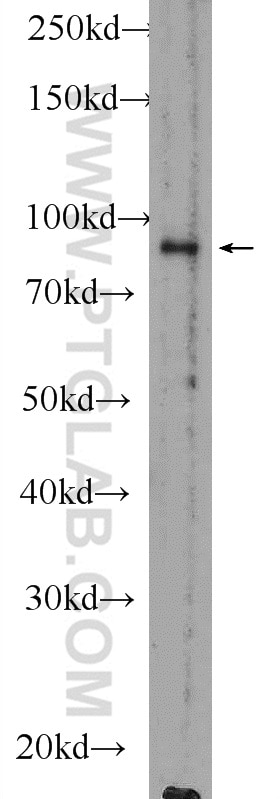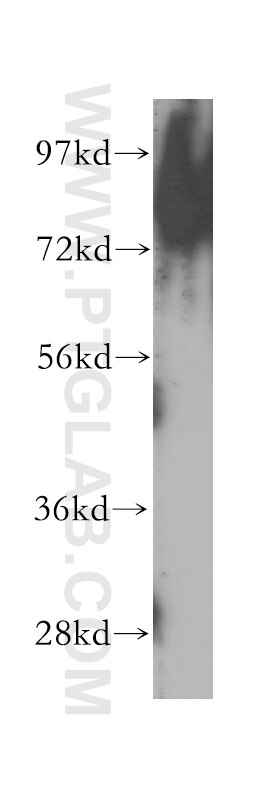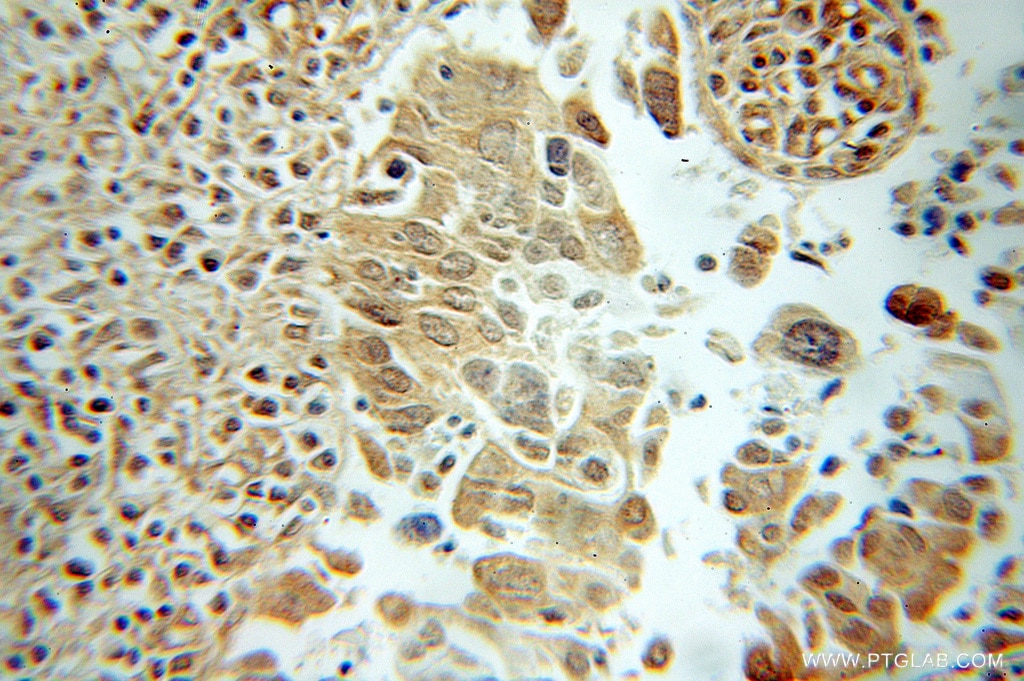Tested Applications
| Positive WB detected in | mouse testis tissue |
| Positive IHC detected in | human cervical cancer tissue Note: suggested antigen retrieval with TE buffer pH 9.0; (*) Alternatively, antigen retrieval may be performed with citrate buffer pH 6.0 |
Recommended dilution
| Application | Dilution |
|---|---|
| Western Blot (WB) | WB : 1:500-1:1000 |
| Immunohistochemistry (IHC) | IHC : 1:20-1:200 |
| It is recommended that this reagent should be titrated in each testing system to obtain optimal results. | |
| Sample-dependent, Check data in validation data gallery. | |
Published Applications
| WB | See 1 publications below |
| IHC | See 1 publications below |
| IP | See 1 publications below |
Product Information
51038-1-AP targets RANBP9 in WB, IP, IHC, ELISA applications and shows reactivity with human, mouse samples.
| Tested Reactivity | human, mouse |
| Cited Reactivity | human, mouse |
| Host / Isotype | Rabbit / IgG |
| Class | Polyclonal |
| Type | Antibody |
| Immunogen |
CatNo: Ag0428 Product name: Recombinant human RANBP9 protein Source: e coli.-derived, PGEX-4T Tag: GST Domain: 571-788 aa of BC052781 Sequence: ASGKGSTAHFSGFESCSNGVISNKAHQSYCHSNKHQSSNLNVPELNSINMSRSQQVNNFTSNDVDMETDHYSNGVGETSSNGFLNGSSKHDHEMEDCDTEMEVDSSQLRRQLCGGSQAAIERMIHFGRELQAMSEQLRRDCGKNTANKKMLKDAFSLLAYSDPWNSPVGNQLDPIQREPVCSALNSAILETHNLPKQPPLALAMGQATQCLGLMARSG Predict reactive species |
| Full Name | RAN binding protein 9 |
| Calculated Molecular Weight | 729 aa, 78 kDa |
| Observed Molecular Weight | 80-90 kDa |
| GenBank Accession Number | BC052781 |
| Gene Symbol | RANBP9 |
| Gene ID (NCBI) | 10048 |
| RRID | AB_670523 |
| Conjugate | Unconjugated |
| Form | Liquid |
| Purification Method | Antigen affinity purification |
| UNIPROT ID | Q96S59 |
| Storage Buffer | PBS with 0.02% sodium azide and 50% glycerol, pH 7.3. |
| Storage Conditions | Store at -20°C. Aliquoting is unnecessary for -20oC storage. 20ul sizes contain 0.1% BSA. |
Protocols
| Product Specific Protocols | |
|---|---|
| IHC protocol for RANBP9 antibody 51038-1-AP | Download protocol |
| WB protocol for RANBP9 antibody 51038-1-AP | Download protocol |
| Standard Protocols | |
|---|---|
| Click here to view our Standard Protocols |
Publications
| Species | Application | Title |
|---|---|---|
Front Immunol A T Cell Suppressive Circuitry Mediated by CD39 and Regulated by ShcC/Rai Is Induced in Astrocytes by Encephalitogenic T Cells. | ||
J Cell Sci Tex19 paralogs are new members of the piRNA pathway controlling retrotransposon suppression. | ||
J Neuropathol Exp Neurol Gene expression profiling of NF-1-associated and sporadic pilocytic astrocytoma identifies aldehyde dehydrogenase 1 family member L1 (ALDH1L1) as an underexpressed candidate biomarker in aggressive subtypes. |








